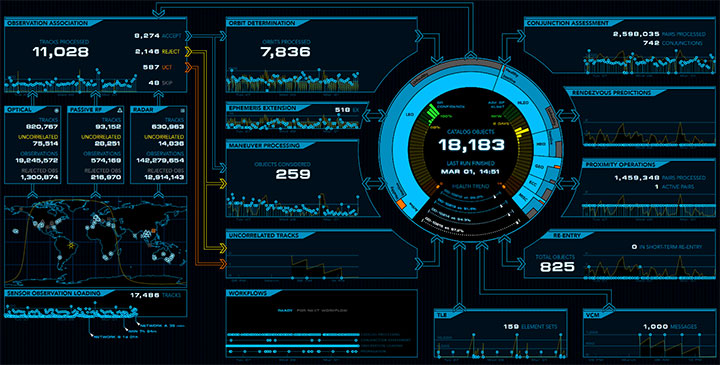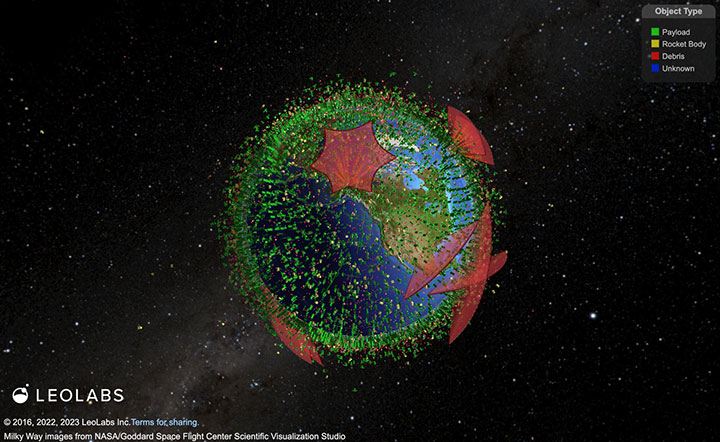COLORADO SPRINGS — Few issues are of greater importance to the U.S. Space Force than the ability to identify, track and characterize objects in space on an operationally relevant timeline. Yet, despite the urgency of the mission and advanced commercial capabilities, Space Force is not leveraging available SDA solutions in a meaningful way.
An April Government Accountability Office report confirmed what many vendors have known for years. Programs intended to evaluate and acquire SDA data licenses to support the DoD mission “have been limited to a few studies and training events.” Even commercial data incorporated into the Unified Data Library (UDL), the cloud-based repository for government and commercial data, is not being used in daily SDA missions. This is driven, in part, by commercial and DoD data being stored on separate systems, formatted differently and not incorporated automatically for operational use, creating “significant disincentives for using the UDL.”
Space Force officials have acknowledged they are facing a big problem, especially in low Earth orbit. Speaking at the Space Symposium, Chief of Space Operations Gen. Chance Saltzman warned that “capabilities for space awareness are still lagging.”
 Chief of Space Operations for U.S. Space Force Gen. Chance Saltzman addresses an audience at the 38th Space Symposium, Wednesday, April 19, 2023. (Source: Space Foundation)
Chief of Space Operations for U.S. Space Force Gen. Chance Saltzman addresses an audience at the 38th Space Symposium, Wednesday, April 19, 2023. (Source: Space Foundation)
In just the last five years, there has been a nearly tenfold increase in the number of satellites operating in LEO. DoD is currently tracking some 47,000 pieces of orbital debris, nearly twice as much as it was tracking in 2019. Norms of behavior as they exist in other military domains simply haven’t been established and continued access to space is not assured.
“The threats in space are scaling,” said LeoLabs Founder and CEO Dan Ceperley. “Legacy space domain awareness systems were not built to scale; they were built in the Cold War. Now, commercial industry is bringing all of these solutions and they are scaling.”
Dozens of vendors with advanced ground and space-based sensor networks, data fusion tools, analytics and flight-tested software solutions make up the SDA commercial market. Many have solutions that could meet DoD needs immediately but continue to encounter roadblocks. Behind the scenes, there is growing frustration among commercial providers, policymakers and even military officials who are looking for ways to succeed in the SDA mission and support a thriving commercial space industry.
Two-Month Contracts
In recent years, there has been a series of efforts to make it easier for commercial providers to work with Space Force. The service has stood up new offices and programs designed to seed private innovation and improve the speed of testing, validating and incorporating commercial SDA capabilities.
The Joint Task Force-Space Defense Commercial Operations cell (JCO) was stood up as the SDA marketplace or storefront inside SSC. The JCO is supported by the newly rebranded Commercial Space Office (COMSO), led by Col. Rich Knisely, which aims to be a “one-stop shop” for government buyers to purchase commercial space data and services.
Through these efforts, Space Force appears to be embracing administrative mandates to buy what it can and build only what it must. Vendors are optimistic about the changes, but also skeptical of the service’s ability to chart a new course.
“They say all the right things. And that’s a plus. Three years ago, they weren’t even saying the right things,” said Jim Cooper, SSA Solutions Lead at COMSPOC, a space domain awareness software solutions provider. “They’re proud of the SDA marketplace and other efforts. I think they’re trying…but it’s all kind of small potatoes.”
In a briefing with reporters at Space Symposium, Brig. Gen. Timothy Sejba, SSC program executive officer for space domain awareness noted that one of the strengths of the office is that it awards short-term contracts—typically two months—to multiple vendors.
“This is how we’re using the power of commercial industry to really show what they’re capable of doing and we’re continuing to invest in them as long as they continue to show improvements and value to the overall initiative,” Sejba said in response to a question from Constellations.
 Image from March 2023 of COMSPOC’s Software Suite Engine Room depicting its enterprise software capabilities for complete space domain awareness. (Source: COMSPOC)
Image from March 2023 of COMSPOC’s Software Suite Engine Room depicting its enterprise software capabilities for complete space domain awareness. (Source: COMSPOC)
“For those that continue to perform and they perform really well, we’ll give them a follow-on contract,” he added. “I actually think it’s a win-win.”
It’s unclear how much that model is shaped by the lack of a budget for commercial SDA data. Among the findings in the GAO report was that commercial SDA data purchases were being funded on an ad-hoc basis, often month-to-month. It was only in the FY 2023 budget that Space Force announced plans to provide $20 million for SDA data. That funding is expected to reach to roughly $110 million between 2023 and 2027.
More Than Data
Not having annual or multi-year commercial SDA contracts creates obvious issues for vendors, not the least of which is planning instability and difficulty attracting private capital. Additionally, few companies are in the business of merely providing data.
LeoLabs tracks objects in space using its network of ground-based radars, but much of the value comes from its cloud-based software platform that produces alerts and insights for end users. Ceperley is hopeful that the old acquisition model of piecing together individual pieces of the SDA mission—raw data, signals processing, analytics—is beginning to fade away.
“That’s great because it frees up those end users. Someone doing space traffic coordination or someone on the intel side monitoring suspicious behavior doesn’t have to worry about piecing together this massive technology stack. They can focus on their mission,” he said. “Put the responsibility on your suppliers of getting all the way to the insight.”
COMSPOC supports “the whole SDA processing chain,” Cooper explained, noting the current JCO model is “not the right fit for the company, and more importantly, doesn’t leverage the comprehensive commercial software solutions available today."
COMSPOC owns a sensor network, can ingest and fuse third-party data through its SSA Software Suite and currently supports space domain awareness services to the Space Data Association.
“There’s a historic cultural mindset amongst DoD people that data is the solution to everything and that if we had more data it would somehow solve the problem,” Cooper said. “They have more data than anybody else in the world. The problem is their analytics, their modeling and their processing are not sufficient.”
The second-generation Space Fence is the world’s most advanced radar capable of making 1.5 million observations per day of objects in orbit as small as a few centimeters. At the same time, DoD still relies on the legacy Space Defense Operations Center (SPADOC), fielded in 1979, for command and control. Efforts to modernize SPADOC and replace it with a more effective enterprise infrastructure to process and operationalize SDA data have been ongoing for three decades. This included the Joint Space Operations Center Missions System (JMS), which was abandoned in 2018, and the Advanced Tracking and Launch Analysis System (ATLAS), which is currently a year behind schedule.
A Better Buyer
Commercial stakeholders are watching closely as Space Force reimagines the new Commercial Space Office and finalizes a strategy for integrating commercial space services.
Hugh White, the senior director of space domain awareness solutions at Kratos is hopeful the new approach will avoid past pitfalls. “With the JCO, we’ve learned valuable lessons on what works and what doesn’t,” he said. “The Commercial Space Office stand up is the right time to apply these lessons to create a model that works for both industry and government.”
For all the trade shows geared toward military buyers, one company noted that the DoD has a problem with market analysis. There are commercially available capabilities and systems at a sufficient technology readiness level that are not being leveraged, including those that have already passed DoD evaluations.
 LeoLabs visualization of 19,0000+ objects in LEO. LeoLabs provides mapping and SSA data for low Earth orbit for collision prevention, risk assessment, constellation monitoring and space situational awareness. (Source: LeoLabs)
LeoLabs visualization of 19,0000+ objects in LEO. LeoLabs provides mapping and SSA data for low Earth orbit for collision prevention, risk assessment, constellation monitoring and space situational awareness. (Source: LeoLabs)
Speaking on background to Constellations, a source involved in commercial SDA commented on the ongoing challenge of DoD preferring its exquisite systems, even as events on the battlefield demonstrate that the quantity of commercial capabilities has a quality in itself.
“What we’re facing in the real world is far more dangerous than the risk we take in saying yes to these good ideas,” the source said.
The DoD’s Defense Space Strategy, National Defense Strategy and the Space Command’s Commercial Integration Strategy all call for DoD to prioritize the use of commercial space capabilities when possible, such as when those capabilities meet or come close to meeting department requirements.
Space Force reported it is actively taking steps to improve the process for identifying and evaluating commercial space situational awareness capabilities to meet its needs. Both the Air Force and Space Force are collaborating on a Commercial Space Strategy due to be released at the end of June.
Space Force leadership is publicly promoting a reevaluation of cultural and organizational norms for a fundamentally different space operating environment. Young Guardians “do not carry around the same baggage of earlier eras of space operations…and they wonder why the institutions are holding onto old methods and mindsets,” said Gen. Saltzman.
“We must pivot,” he continued. “The old ways of doing business are too slow, too late to need, and too behind the times to meet the challenges we face.”
Explore More:
Podcast: Col. Michelle Idle: Intentional Collaboration and Turning the Ship Around
Podcast: Dr. Frank Turner: Spiral Development, TRLs and Being a Constructive Disruptor
Podcast: Maj. Gen. John Shaw: The Need to Defend Space and the Tyranny of Volume
‘Free the Data’: SSC Calls for Great Info-Sharing Among Allies
Why DIA Wants More Commercial SDA Partners
